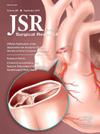Novel Low-Cost Low-Fidelity Abdominal Wall Simulation is Effective for Surgical Education
IF 1.7
3区 医学
Q2 SURGERY
引用次数: 0
Abstract
Introduction
Surgical training increasingly employs simulation to facilitate resident education. However, simulations are often costly or use animal tissues, with attendant challenges in their financial and logistical feasibility. We present a foam abdominal wall model for abdominal access and ostomy creation.
Methods
Layers of craft foams and fabrics are used to accurately simulate the layers of the abdominal wall, both on and off midline. Sixteen general surgery junior residents were proctored by a colorectal surgeon to complete each simulation. Residents completed pretask and post-task 5-point Likert-scale regarding comfort with technical skills. Improvement in these metrics was the primary outcome of interest. Wilcoxon matched pairs signed rank test was performed, preselected alpha was set at 0.05.
Results
Residents reported that their confidence in all aspects of stoma creation improved following completion of the lab. On prelab versus postlab survey, residents significantly increased in overall technical comfort by 2 points (P < 0.001), comfort in siting the stoma by 1 point (P < 0.001), creating the trephine by 2 points (P < 0.001), and securing the stoma by 1 point (P < 0.001). On pretest versus post-test survey residents significantly improved their technical comfort with Veress needle by 2 points (P < 0.001), optical trocar by 1 point (P < 0.001), and Hasson by 1.5 points (P < 0.001).
Conclusions
This model is easy to make and effective in increasing resident-reported comfort with ostomy formation and abdominal access. This offers an opportunity for residents to practice critical procedures in general surgery at low-cost and with no associated patient risk.
新型低成本低保真腹壁模拟技术在外科教育中的应用。
前言:外科训练越来越多地采用模拟来促进住院医师的教育。然而,模拟通常是昂贵的或使用动物组织,在其财政和后勤可行性方面伴随着挑战。我们提出一个泡沫腹壁模型腹腔通道和造口。方法:采用多层工艺泡沫和织物准确模拟腹壁层,包括中线上和中线外。16名普通外科初级住院医师由一名结直肠外科医生监督完成每个模拟。受试者完成了任务前和任务后关于技术技能舒适度的李克特5分量表。这些指标的改善是主要的结果。采用Wilcoxon配对对符号秩检验,预设α值为0.05。结果:住院医师报告说,他们对造口的各个方面的信心在实验室完成后都有所提高。在实验前和实验后的调查中,住院医生在整体技术舒适度上显著提高了2个点(P < 0.001),在造口位置上的舒适度提高了1个点(P < 0.001),在造口位置上的舒适度提高了2个点(P < 0.001),在造口位置上的舒适度提高了1个点(P < 0.001)。在测试前与测试后的调查中,居民使用Veress针的技术舒适度显著提高了2个点(P < 0.001),光学套管针提高了1个点(P < 0.001), Hasson针提高了1.5个点(P < 0.001)。结论:该模型易于制作,可有效提高住院医师对造口形成和腹部通路的舒适度。这为住院医生提供了一个机会,在普通外科中以低成本和无相关患者风险的方式实践关键程序。
本文章由计算机程序翻译,如有差异,请以英文原文为准。
求助全文
约1分钟内获得全文
求助全文
来源期刊
CiteScore
3.90
自引率
4.50%
发文量
627
审稿时长
138 days
期刊介绍:
The Journal of Surgical Research: Clinical and Laboratory Investigation publishes original articles concerned with clinical and laboratory investigations relevant to surgical practice and teaching. The journal emphasizes reports of clinical investigations or fundamental research bearing directly on surgical management that will be of general interest to a broad range of surgeons and surgical researchers. The articles presented need not have been the products of surgeons or of surgical laboratories.
The Journal of Surgical Research also features review articles and special articles relating to educational, research, or social issues of interest to the academic surgical community.

 求助内容:
求助内容: 应助结果提醒方式:
应助结果提醒方式:


